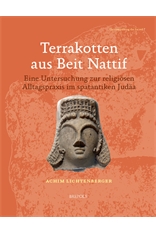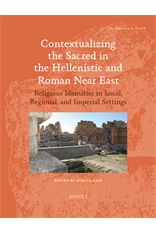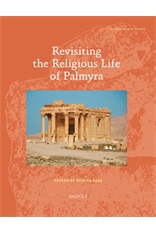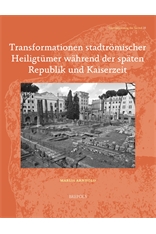Edited by Elizabeth Frood & Rubina Raja
xx + 260 p., 57 b/w ills., 9 col. ills., 156 x 234 mm, 2014, CS 1, HB, ISBN 978-2-503-54104-4, € 80
Language(s): English, French, German
This launch volume of the series “Contextualizing the Sacred” explores the changing social, religious, and political meanings of sacred space in the ancient Near East through bringing together the work of leading scholars of ancient history, Assyriology, classical archaeology, Egyptology and philology.
Redefining the Sacred originates in an international European Science Foundation Exploratory Workshop of the same name held at the University of Oxford in 2009 , and is the launch volume for the series Contextualizing the Sacred. It comprises eight studies written by leading scholars, each of whom investigates aspects of the diverse and changing meanings of sacred environments in the Near East and Egypt from c. 1000 BC to AD 300. This was a time of dramatic social, political, and religious transformation in the region, and religious architecture, which was central to ancient environments, is a productive interpretive lens through which implications of these changes can be examined across cultural borders. Analysis of the development of urban, sub-urban, and extra-urban sanctuaries, as well as the written sources associated with them, shows how the religious identities of individuals, groups, and societies were shaped, transformed, and interconnected. By bringing together ancient historians, Assyriologists, Egyptologists, archaeologists, and philologists, the volume highlights the immense potential of diachronic studies of sacred space, which the series will take forward.
xvi + 323 p., 194 b/w ill., 1 b/w tables, 216 x 280 mm, 2014, CS 2, PB, ISBN 978-2-503-54437-3, € 120
Language(s): English
The aim of this book is to show how architecture can illuminate the functions of religious assemblies of various kinds in ancient society.
The architecture of ancient religious spaces has the potential to offer a deeper understanding of the religious groups who used the spaces and the activities they performed there. However, the large corpus of recent scholarship has for the most part overlooked architecture. This book investigates the spatial and architectural settings of mystery cults and religious assemblies from the eighth century bc to the fourth century ad and shows how architecture can illuminate the contents and societal functions of ancient religions. It examines deities whose cults included mysteries and/or were served by religious associations in the ancient world. Chapters treat the old Greek mystery cults of Demeter in Eleusis and the Great Gods in Samothrace as well as those of Dionysos, and the ‘foreign’ deities Isis/Serapis, Cybele/Attis, and Mithras. The book also treats religions and cults that did not include mysteries but were served by special religious groups, such as those belonging to the Syrio-Phoenician gods, the Jewish god in the diaspora, and the Christian god. The last section of the book combines the typological results from the first section on architecture with the presentation of the cultic functions of religious groups in the second section. This comparative analysis seeks to understand the social and spatial context for the activities of cults with a main focus on the Hellenistic and Roman periods, in particular through distinguishing the differences and similarities in the use of specific room-types.
Anika Greve
xiii + 328 p., 144 b/w ills., 216 x 280 mm, 2014, PB, CS 3, PB, ISBN 978-2-503-54409-0, € 120
Language(s): German
[ENG] In the ancient Mediterranean, various architectural styles of courts - atriums, forecourts and courtyards - are frequently used in the context of tombs. These rooms within tombs developed from a special need of the resident population, which emerged from their specific belief in the afterlife. Some courts had elaborate walls and special facilities that were integrated e.g. for offerings or water supply, which points to a common function of these courts. Miscellaneous finds of cult-related objects as well as plain ware confirm the importance of these rooms for religious interaction. This book compares sepulchral courts from three selected regions - Alexandria in Egypt, Nea Paphos in Cyprus and Cyrene in Libya. It shows how, in Hellenistic times, the architecture of the tombs as well as the architecture of the courts strongly diverge, not only in structure and different features, but also in the function and sense of these courts. Besides a comparison to the tombs and their courts of the rest of the Mediterranean world, a study of the different models of court is included. The book concludes by considering the extent to which it is possible to reconstruct specific beliefs in the afterlife and different practices in the analysis of these courts.
Edited by Michael Blömer, Achim Lichtenberger & Rubina Raja
xxxviii + 424 p., 294 b/w ill. + 12 Maps, 216 x 280 mm, ISBN 978-2-503-54445-8, € 135
Language(s): English, French, German
This volume addresses questions of continuity and change in the religious life of the Levant between Alexander’s conquest of the Middle East until the end of the Umayyad period, a topic which has received growing attention over the last decade within the fields of ancient history, archaeology, philology, and religious studies. The volume pulls together the efforts of scholars from all of these fields, and its central concerns include the representations and expressions of religious identity in sacred architecture, iconography, and texts. These representations and expressions are explored through literature, inscriptions, and iconography, and though the architectural as well as the functional development of sanctuaries, churches, and mosques. The volume includes papers on themes such as definition, creation, dissolution, and interconnection between sacred sites, as well as access and audience. These developments are examined through the lenses of aspects of continuity and change in material and literary culture.
With a point of departure in the development of urban, sub-urban, and extra-urban sanctuaries, churches, and early mosques, as well as their associated cults and religions, the contributions in this volume explore the shaping and development of the religious identities of individuals, groups, and societies, and assess how these categories of religious identity were interrelated and shaped by a variety of circumstances. The volume aims at underlining the importance of interdisciplinary studies to the comprehensive understanding of this complex field and at opening up discussions of methodological and theoretical approaches which can be used across these disciplines.
Edited by Linda Marie Günther & Bärbel Morstadt
XVIII+159 p., 40 b/w ill., 156 x 234 mm, ISBN: 978-2-503-54457-1, € 75
Languages: German, Latin, Greek
This volume explores the diversity of ancient religious practices in the context of wide-ranging cultural contacts between Phoenicians, Greeks and Romans, bringing together the work of leading scholars and young researchers of Ancient History and Classical Archaeology.
The interpretatio of deities is a cultural phenomenon, which is grounded in the well-studied trade and colonisation activities by Greek poleis and the formation of the Roman empire. This phenomenon is traditionally viewed as an expression of the self-acculturation of indigenous groups and as a means of systematically homogenising diversity. The papers in this volume seek more complex and nuanced perspectives based on detailed contextual analyses. They present detailed studies of different features of this vast field of trans-cultural interpretation of Phoenician, Greek and Roman deities in the first millennium BC, ranging from Heracles to Aphrodite and spanning geographically from the Levant to the Iberian peninsula Each case-study focuses on the particular implementation process and evaluates it on its own terms, within its own individual context.
This volume originates in a workshop held at the University of Bochum, Käte Hamburger Kolleg at the Center for Religious Studies “Dynamics in the History of Religions”, in 2010. It comprises seven studies, written by leading scholars as well as junior researchers of Ancient History and Classical Archaeology.
Edited by Oren Tal & Zeev Weiss
XXIV+290 p., 199 b/w ill., 3 b/w tables, 216 x 280 mm, ISBN: 978-2-503-55335-1, € 120
Languages: English
Cultic Manifestations in the Southern Levant in the Greco-Roman Period
The arrival of Alexander the Great in the southern Levant ushered in many changes, and the subsequent period saw many more upheavals, including the Roman conquest, the Jewish revolts, and the gradual Christianization of the Holy Land. Throughout this period, many local ‘pagan’, Jewish, and Christian cults and cultic places dotted the local landscape of the southern Levant, which today covers the area of Israel, Jordan, and parts of Lebanon and southern Syria. These cults underwent processes of profound change, but also preserved much of their older identities while still interacting with each other.
This volume seeks to present these processes both synchronically and diachronically, along three different axes – cultic places, personnel, and objects. The common denominator shared by these three axes is the people whose beliefs and practices shaped religious behaviour in the Greco-Roman southern Levant. The 18 articles in this volume investigate whether cultic practices formed a coherent cultural system. They consider the co-existence and competition of the different religious systems, analyzing them in terms of continuity, discontinuity, and change over an extended period of time, roughly from the arrival of Alexander the Great to the Imperial integration of Christianity (ca. late fourth century BCE - early fifth century CE). The approaches presented in the volume are varied and interdisciplinary, combining archaeological, philological, historical, and art-historical analyses of multiple bodies of evidence.

XVI+299 p., 440 b/w ill. + 6 colour ill., 216 x 280 mm, ISBN: 978-2-503-56884-3, € 110
Languages: German
The first comprehensive publication and exhaustive study on the terracotta figurines found in two Roman cisterns in Beit Nattif in Judaea.
This is the first comprehensive publication and exhaustive study on the terracotta figurines found in two Roman cisterns in Beit Nattif in Judaea. In total more than 400 figurines, mainly females, riders and animals from Beit Nattif and other places are classified, discussed and interpreted in this monograph. These figurines have a very characteristic style and they display only little Greco-Roman influences. The repertoire and iconography can be related to forerunners from the Iron Age. The terracotta figurines from Beit Nattif are important evidence for religious practices in the region and they offer the possibility to discuss the religious affiliation as well as the religious or magic practices of their owners. The study argues that the figurines attest to a local population in post Bar-Kochba Judaea, which was deeply rooted in a Near Eastern Semitic tradition. They used models and concepts which were familiar to Jewish and pagan traditions and the find complex raises the question about the religious affiliation of the consumers of the figurines.
Mit der vorliegenden Studie wird erstmals der Gesamtbestand der figürlichen Terrakotten aus zwei römerzeitlichen Zisternen in Beit Nattif in Judäa vorgelegt. Mehr als 400 Terrakotten – überwiegend weibliche Figuren, Reiter und Tiere – aus Beit Nattif und von anderen Fundplätzen in der Region werden beschrieben, klassifiziert und umfassend interpretiert. Die Terrakotten haben einen charakteristischen Stil und sind nur schwach von griechisch-römischer Ikonographie beeinflusst. Das Repertoire und die Ikonographie verweisen aber auf Vorläufer in der Eisenzeit. Die Terrakotten aus Beit Nattif sind ein wichtiger Befund für religiöse Praktiken im römisch-spätantiken Judäa und bieten die Möglichkeit, religiöse Identitäten sowie religiöse und magische Praktiken ihrer Besitzer zu untersuchen. Es zeigt sich, dass die Terrakotten mit einer Lokalbevölkerung zu verbinden sind, die stark in vorderorientalischen semitischen Traditionen verwurzelt war. Diese Bevölkerung orientierte sich an Modellen und Konzepten, die anschlussfähig sowohl an jüdische als auch an pagane Traditionen waren. Die Monographie ist damit ein wichtiger Beitrag zur Diskussion um materielle Kultur und religiöse Identitäten in Judäa in der Zeit nach dem Bar-Kochba-Krieg (132-135 n. Chr.).

Edited by Rubina Raja
XX+256 p., 100 b/w ill., 216 x 280 mm, ISBN: 978-2-503-56963-5, € 120
Languages: English, German, French
This edited volume consists of 15 contributions by leading scholars of religious identity and religion in the Hellenistic and Roman Near East.
The study of religion and religious identities in the Hellenistic and Roman Near East has been a focus within archaeology and ancient history for centuries. Yet the transition between the Hellenistic and Roman period remains difficult to grasp from the archaeological and epigraphic evidence. This volume brings together contributions by leading scholars working on religious identity and religion in the Hellenistic and Roman periods in the Roman Near East. For this volume they have been asked to address a variety of questions concerning religion, religious development, and religious identities from the Hellenistic period to Late Antiquity. These research questions have resulted in a suite of contributions which draw upon a wide range of empirical evidence, from epigraphical material to literary and archaeological sources. In the ancient Near East we cannot speak of a common religion, nor of a common literary tradition, but when seen through the lens of contextualization, the material and textual evidence brings forward new narratives about the great variations in worship, myths, and identities, as well as the different religious systems of the region and of the people inhabiting it. The contributions offer concretized ideas about and research on various aspects of religion within a framework of very different settings, of local, regional, or imperial character.
This volume is a must for any scholar or student of the Hellenistic, Roman, and Late Roman Near East, and the contributions provide new insights into the ways in which we may approach this region, offering complex but plentiful material to be studied.

Edited by Rubina Raja
XIV+212 p., 135 b/w ill., 216 x 280 mm, ISBN: 978-2-503-57635-0, € 90
Languages: English, French
Revisiting the Religious Life of Palmyra is the first volume ever bringing together the core group of scholars who have worked on religion and religious practice in Palmyra.
The oasis city of Palmyra in the Syrian Desert has long been the focus of scholarly attention, both as a major cultural locus at the heart of the ancient world, active in trade and politics, and as an important local centre of religion, attested through the archaeology and historical sources related to the site. In this volume, which is the outcome of a conference organized within the framework of the Palmyra Portrait Project, the latest research from scholars working on Palmyra is drawn together to offer new insights into both the city’s religious life and its wider implications for our understanding of religious life in the Near East in general in the first three centuries CE. Incorporating analyses and discussions of archaeological, epigraphic, and literary sources that shed light on Palmyrene religion, the contributions gathered here reassess and discuss the beliefs and practices that were followed in the city, assess the different cults that existed, and present new insights into the development and function of the city’s religious communities and spaces. Together, these chapters provide a vital update to our understanding of how people lived and worshipped in this city, which remains crucial to the broader understanding of the role of religion and religious practices in urban contexts in antiquity.

Approx. 390 p., 95 b/w ill. + 1 colour ill., 90 b/w tables, 216 x 280 mm, ISBN: 978-2-503-58835-3, € 130
Languages: German
What happened with the Republican temples in Imperial Rome? How were these used? Which building activities affected their appearance and function?
Was geschah in der Stadt Rom mit den republikanischen Tempelbauten während der Kaiserzeit? Wie wurden diese (noch) genutzt? Welchen baulichen Veränderungen unterlagen sie?
Neue Akteure, veränderte Machtverhältnisse, eine ganze Stadt im Wandel, zunehmend begrenzter Raum, wegfallende Sichtachsen, letztendlich aber auch neue Kulte sowie neue Formen von Kultbauten und -praktiken bestimmen den Rahmen, vor dem auch das Fortbestehen der bereits in republikanischer Zeit vorhandenen Heiligtümer betrachtet werden muss. Dabei zeichnet sich ein Bild ihrer Nutzungsweisen und Funktionen, das kaum heterogener sein könnte, sich bei näherer Betrachtung jedoch sinnvoll zu einem Ganzen verbindet. Geprägt von Pragmatismus und dem Repräsentationswillen verschiedener Akteure spiegelt sich im unterschiedlichen Umgang mit den Heiligtümern die räumliche und funktionale Segmentierung der kaiserzeitlichen Stadt eindrucksvoll wider. Dabei steht weit mehr als die Rekonstruktion der bisher häufig vernachlässigten kaiserzeitlichen Phasen ausgewählter Heiligtümer im Vordergrund. Es sind die Einbettung der Architekturen und Räume dieser Stätten in das urbane Umfeld, die Konzeption städtischen Raumes und insbesondere auch die Frage, welche Rolle den ‚alten‘ Kulten in einer ‚neuen‘ Stadt beigemessen wurde, die das Augenmerk dieses Buches bilden.
Marlis Arnhold, born in 1981, studied Classical Archaeology in Leipzig and Cologne. From 2008 until 2013 she was a member of the Max-Weber-Center for Advanced Cultural and Social Studies at the University of Erfurt, where she conducted her doctoral studies and was a postdoc researcher in the ERC-Project "Lived Ancient Religion: Questioning ‘Cults’ and ‘Polis Religion’" (Grant no. 295555, Jörg Rüpke). From 2013 to 2019, she was Akademische Rätin at the Department of Classical Archaeology at Bonn, and since then she has worked as an independent researcher.
Marlis Arnhold, geboren 1981, studierte in Leipzig und Köln Klassische Archäologie. Von 2008 bis 2013 war sie Mitglied des Max-Weber-Kollegs für kultur- und sozialwissenschaftliche Studien an der Universität Erfurt, wo sie ihre Dissertation abschloss und als Postdoc-Mitarbeiterin im ERC-Projekt "Lived Ancient Religion: Questioning ‘Cults’ and ‘Polis Religion’" (Grant no. 295555, Jörg Rüpke) tätig war. Von 2013 bis 2019 war sie Akademische Rätin an der Abteilung Klassische Archäologie der Universität Bonn und ist seither als unabhängige Wissenschaftlerin tätig.